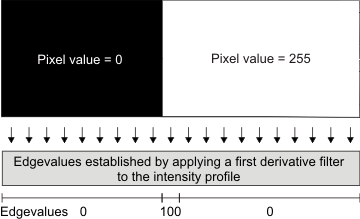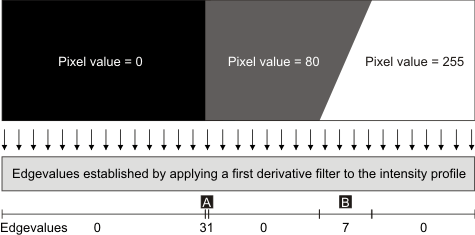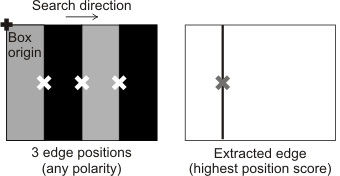Edge markers: advanced characteristics that can be specified
- See also

 Availability
Availability 
 Previous
Previous
- Next

This section describes the characteristics of an edge marker that you would usually set for advanced applications, when the correct marker is difficult to find. These characteristics fall into two categories: those that must be met (essential characteristics) and those for which you can set a range of acceptable scores (score characteristics).
Essential characteristics
To specify an advanced essential characteristic of a marker, use MmeasSetMarker(). MIL only finds a marker occurrence if it meets all the essential characteristics set in the marker buffer.
Maximum association distance of subedges
The maximum association distance (M_MAX_ASSOCIATION_DISTANCE) determines the farthest a subedge can be from the fitted edge position, for MIL to consider it part of the edge marker. By default, the maximum association distance is unlimited; that is, MIL uses the entire box search region to establish markers. Typically, you might want to restrict the maximum association distance in certain types of noisy images, where MIL can interpret the noise as subedges, which can then be incorrectly used to fit the marker.
To manage such situations, you should usually try restricting the size of the box search region; however, this might not always be convenient. For instance, if noisy images are rare but the edge location often varies, you might not want to reduce the box search region, although you have to account for an occasional noisy image that skews your results. In these cases, you can use M_MAX_ASSOCIATION_DISTANCE to restrict the image data that MIL uses to establish the marker.
MIL measures the specified maximum distance from the center of the fitted edge along a straight line that is parallel to the search direction. Subedges that fall outside the maximum association distance do not affect the marker's fit operation even if they are in the box search region. Therefore, you can consider M_MAX_ASSOCIATION_DISTANCE as a way of restricting the image data that MIL uses to establish the edge, when it is not practical to decrease the size of box search region (or subregions).
Although the maximum association distance applies to subedges, you might still need to specify it when dealing with noisy images, even if you have not explicitly subdivided the box search region into subregions (subedges). For example, to calculate an edge marker's line equation (mean line), MIL internally uses three subedges, even if you did not specify them (three fit points are a requirement to calculate a line). If an image has substantial specks (noise) in the subregions, the line that MIL calculates might not be what you expect; for example, it can be at an incorrect angle. By reducing the maximum association distance, the line can be much closer to what is expected.

To retrieve the distance between the calculated marker and its farthest subedge, use MmeasGetResult() with M_FIT_ERROR_MAX. To retrieve the number of outliers (ignored subedges), use MmeasGetResult() with M_NUMBER_OF_OUTLIERS.
Minimum variation
The minimum variation refers to a type of threshold characteristic that you can set to represent the minimum prominence of the required edge peaks for the peak to be considered an occurrence of a marker. Advanced applications might need to specify this characteristic when trying to find multiple neighboring edges in the search region, which are formed such that the foreground of the first edge becomes the background of the next edge. To set the minimum variation characteristic, use M_EDGEVALUE_VAR_MIN. Note that, regardless of the M_EDGEVALUE_VAR_MIN setting, edgevalues must always be greater than the minimum edgevalue specified (M_EDGEVALUE_MIN) to be considered an occurrence of a marker. For more information, see the Minimum variation subsection of the Search algorithm section earlier in this chapter.
Score characteristics
To specify a score characteristic of a marker, use MmeasSetScore(). As previously discussed, the score characteristics only validate markers that have all the essential characteristics. Of these markers, MIL chooses the one with the highest edge strength score, by default. This behavior is typically sufficient and you usually don't have to call MmeasSetScore() unless you are working on advanced applications.
Note that although you can specify multiple score characteristics, this can cause results that are difficult to interpret. It is often sufficient, and simpler, to use one score characteristic with which to find the best marker. Since the marker with the highest (best) strength score is found by default, you should therefore typically disable the strength score characteristic before setting another score characteristic (such as, for example, the contrast). For more information about how MIL calculates scores (as well as how to set a minimum acceptable score), see the Score characteristics section later in this chapter.
Strength score
As discussed earlier in this chapter, an edge's strength refers to its maximum edgevalue. The edge with the greatest strength can be referred to as the strongest edge and is, by default, the edge with the highest score.
The edge's strength can actually refer to what is theoretically the lowest edgevalue (that is, the largest negative edgevalue) since edges can be found with positive or negative polarity. However, for explanatory purposes, the documentation generally refers to edges in the absolute, and therefore only to positive edgevalues and edge strengths.
In the diagram below, the edge's strength is 100, which is the highest strength (and edgevalue) possible. This results from the theoretical case where the edge has a width of one pixel, is perfectly vertical, and has the greatest possible pixel value variation.

Unlike the edge in the above example, the edges A and B in the diagram below do not come from a very high pixel variation, which means a lower strength. Also, since edge B is at an angle (its edge profile is distributed over ten edgevalues), while edge A has an edge width of one pixel, the strength of edge B (7) is less than edge A (31). Therefore, if you are finding an edge marker based on strength, as is the default case, edge A will be chosen.

If you want to find edge B instead of edge A, you can use MmeasSetScore() to disable the strength score characteristic, and use the contrast score characteristic to select the best edge. Since the contrast is typically based on the difference in grayscale values between the start and the end of the intensity transition from which an edge is established, and edge B has a higher contrast (255 - 80 = 175) than edge A (80 - 0 = 80), edge B would have a higher contrast score and be chosen as the edge found. For more information about specifying the contrast score characteristic, see the Contrast score subsection of this section.
To retrieve the calculated edge strength, use MmeasGetResult() with M_EDGE_STRENGTH. To specify the expected edge strength and tolerable variances, or to disable its effect, use MmeasSetScore() with M_STRENGTH_SCORE.
You can also retrieve all the edgevalues of the marker buffer's search region, using MmeasGetResult() with M_BOX_EDGEVALUES. Specifically, this returns the calculated edgevalue for every projection value within the search region. This allows you to determine what MIL will likely consider an edge. You can then use this information to, for example, specify an appropriate value for M_STRENGTH_SCORE.
Contrast score
Contrast generally refers to the distinctiveness of an edge. Setting the contrast score characteristic can be useful when, for example, you must distinguish an edge from several other edges, particularly when the required edge does not have the highest edge strength (usually due to poor illumination, which strength is very dependent on), or when the edge is at an angle.
To specify the contrast score characteristic, use either M_EDGE_CONTRAST_SCORE or M_EDGEVALUE_PEAK_CONTRAST_SCORE, depending on whether you want to determine the contrast based on the positions of the start and end of the edge, or based on positions relative to the minimum and maximum of the edge peak, respectively. For more information, see the Search algorithm section earlier in this chapter.
Position score
As previously discussed, an edge marker's position refers to the position of its maximum edgevalue. With M_DISTANCE_FROM_BOX_ORIGIN_SCORE, you can have MIL calculate a score based on the proximity of the marker's position to the origin of its box search region.
Setting the position score characteristic can be useful when you want to find one particular edge marker that is among several edges that have similar characteristics and are all within the same box search region. For example, in the following illustration, there are three possible edge markers in the box search region, which are virtually identical; therefore, you cannot distinguish between them with score characteristics such as strength and contrast. However, with M_DISTANCE_FROM_BOX_ORIGIN_SCORE, you can find the first marker since it has the highest position score, given that it is the closest to the box origin.
